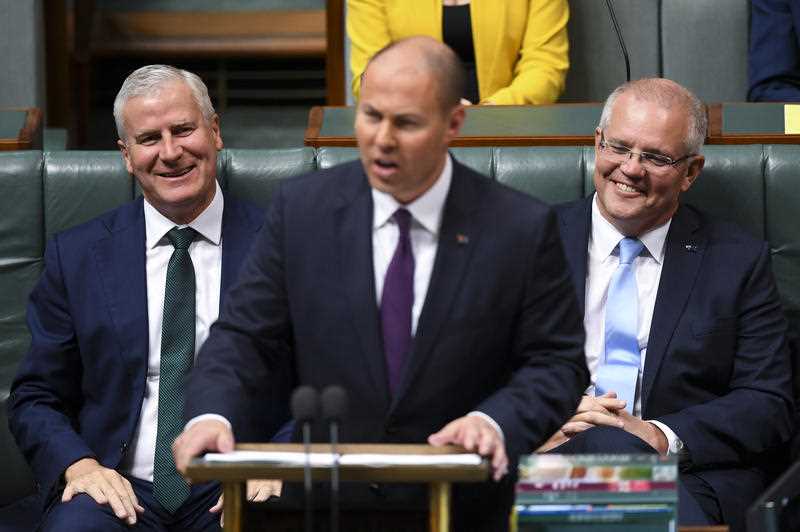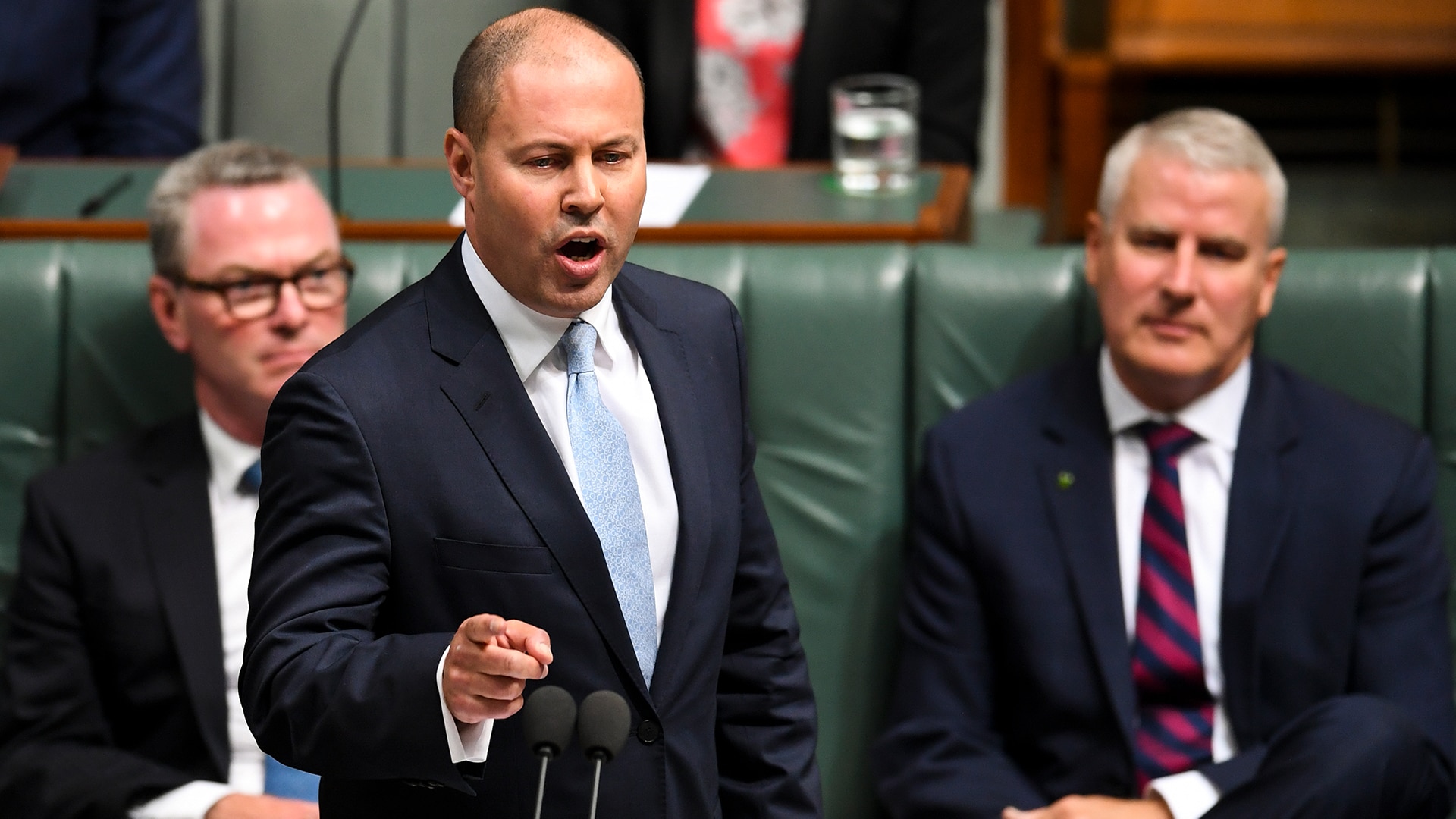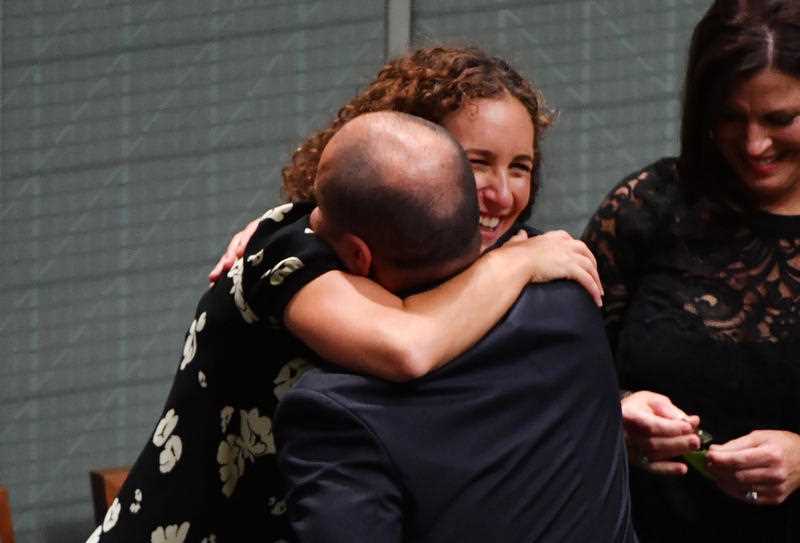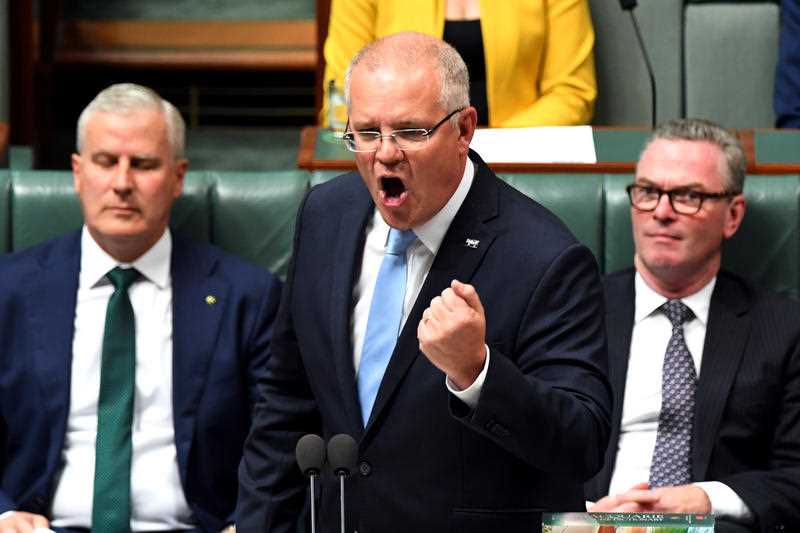Millions of Australian workers will get an extra $1000 back in their pockets and commuters will see a decade of road and rail upgrades in
In a no-losers budget just weeks out from the May election, Treasurer Josh Frydenberg pitched the coalition as responsible economic managers who can still splash some cash.

Prime Minister Scott Morrison and Deputy PM Michael McCormack react as Australian Federal Treasurer Josh Frydenberg hands down the budget. Source: AAP
Infrastructure funding will jump $25 billion to $100 billion over the next 10 years in a bid to connect Australia's job-creating cities with regional population centres.
Mr Frydenberg's first budget also predicts surpluses from next financial year, starting with $7.1 billion in 2019/20.
"The budget is back in the black and Australia is back on track," Mr Frydenberg said on Tuesday night.
Last year's $530 tax offset for low- and middle-income earners has been doubled to $1080 for more than 10 million taxpayers earning up to $126,000 a year.

Treasurer Josh Frydenberg has announced we're "back in back". Source: AAP
About 4.5 million Australian workers will get the full amount, starting from next year's tax returns, should the coalition government be returned.
In 2024, the 32.5 per cent tax rate will drop to 30 per cent, meaning workers earning from $45,000 to $200,000 will pay 30 cents in every dollar.
"We will put a speed limit on taxes, while our opponents will put a speed limit on the economy," Mr Frydenberg said.
But the coalition will not attempt to get the tax cuts through parliament before the election.
The budget's wage growth predictions remain high at 3.25 per cent from 2020 onwards, but other forecasts are more conservative.

Mr Frydenberg is hugged by wife Amie after handing down his first Federal Budget in the House of Representatives. Source: AAP
Mr Frydenberg expects employment growth to drop to 1.75 per cent for the next two years, while the unemployment rate is tipped to remain static at five per cent over the next four years.
To build $100 billion worth of infrastructure projects over the next decade, $525 million will be spent to create an extra 80,000 new apprenticeships in industries with skills shortages.
, while the apprentices themselves will get $2000.
"There will be cranes, there will be hard hats, there will be heavy machinery across the country," Mr Frydenberg said.
The small business instant asset write-off has been increased to $30,000, and the definition has been increased to include businesses with turnover below $50 million a year.
The coalition has avoided touching the three areas Labor is promising to hit if it wins the May election - negative gearing, trusts, and dividend imputation.

Mr Morrison reacts during question time. Source: AAP
"We are not increasing taxes, the Labor party is, that is the clear contest between now and the next election," the treasurer said.
Mr Frydenberg promised to erase Australia's $373 billion of net debt by 2030, starting with a $12 billion reduction in 2019/20.
"We are reducing the debt and this interest bill. Not through higher taxes, but by responsible budget management and by growing the economy," he said.
Key points of the budget:
ECONOMY
- Budget surplus forecast of $7.1 billion, the first in 12 years
- Surplus forecast rising to $11 billion In 2020-21 and then $17.8 billion in 2021-22 before dropping to $9.2 billion in 2022-23
- Goal of eliminating Commonwealth net debt by 2030 or sooner
- Economic growth as measured by GDP to rise to 2.75 per cent
- Unemployment rate steady at 5.0 per cent
- Inflation as measured by CPI to be 2.25 per cent
TAXATION
- $158 billion of additional tax relief for those earning up to $126,000 a year
- Up to $1,080 in savings for single income families and up to $2,160 for dual income families.
- Tax rate lowered from 32.5 per cent to 30 per cent from July 2024 for all taxpayers earning between $45,000 and $200,000
SMALL BUSINESS
- Tax rates cut to 25 per cent by 2021-22
- Increasing access to finance with a new $2 billion fund
- Instant asset write-off increased to $30,000 and expanded to businesses with turnover of up to $50 million
- Additional $60 million for Export Market Development Grants
REGULATION
- Additional support to the Tax Office to reduce tax cheats
- Additional support to financial regulators in the wake of the Banking Royal Commission
INFRASTRUCTURE
- Boosting infrastructure spending to $100 billion over the decade
- Increasing the Urban Congestion Fund four-fold from $1 billion to $4 billion including a $500 million Commuter Car Park Fund
- Providing $2 billion for fast-rail between Melbourne and Geelong as well as fast-rail corridors in other areas
- $2.2 billion for safer roads
- $1 billion to improve freight routes and access to ports
- $100 million for regional airports
THE BUSH
- $6.3 billion in drought support
- $3.3 billion for those affected by flood
- New North Queensland Livestock Industry Recovery Agency
- New $3.9 billion Emergency Response Fund for natural disaster recovery efforts
YOUNG WORKERS
- $525 million skills package
- 80,000 new apprenticeships
- Incentive payments to employers up to $8000 per placement
- New apprentices to receive a $2000 incentive payment
- $62 million to boost literacy, numeracy and digital skills
- Funding to increase participation for women and girls in STEM (science, technology, engineering and maths) industries
RESEARCH
- $9 billion for science, research and technology, including commercialisation
- $400 million for genomics research to unlock the secrets of DNA
- $160 million for research to improve the health of indigenous Australians
HEALTH
- $80 billion for more MRI machines, more life-changing medicines on the PBS, more funding for mental health, better access to GPs, hospitals and dental services
- Funding upgrades to regional hospitals, the first being in Townsville
- Establishing Australia's first comprehensive children's cancer centre in Sydney
- Helping to build a new Brain and Spinal Ward in South Australia
- $461 million for youth mental health and suicide prevention strategy
- $500 million for a Royal Commission into the mistreatment of people with disability
AGED
- $725 million for 10,000 new home care packages
- One-off Energy Assistance Payment for pensioners of $75 for singles and $125 for couples
- $84 million to enable carers to leave a loved one in safe hands and take a break
ENVIRONMENT
- $3.5 billion Climate Solutions Package, $2 billion of which will go to practical emission reduction activities, working with farmers and Indigenous communities
- $100 million Environment Restoration Fund to deliver large-scale environmental projects
SCHOOLS
- committing around $300 billion to all schools, a total increase of 63 per cent for upgrades to libraries, classrooms and play equipment
- new scholarship program for over 1,000 students a year to study in regional Australia
- $453 million to extend pre-school education, enabling 350,000 children to receive 15 hours of quality early learning per week in the year before school
SECURITY
- $328 million to fund prevention, response and recovery initiatives
- $570 million for the Federal Police and ASIO
- Additional $680 million to support service men and women deployed abroad.

